ABS AUDI A8 2013 User Guide
[x] Cancel search | Manufacturer: AUDI, Model Year: 2013, Model line: A8, Model: AUDI A8 2013Pages: 318, PDF Size: 79.34 MB
Page 147 of 318
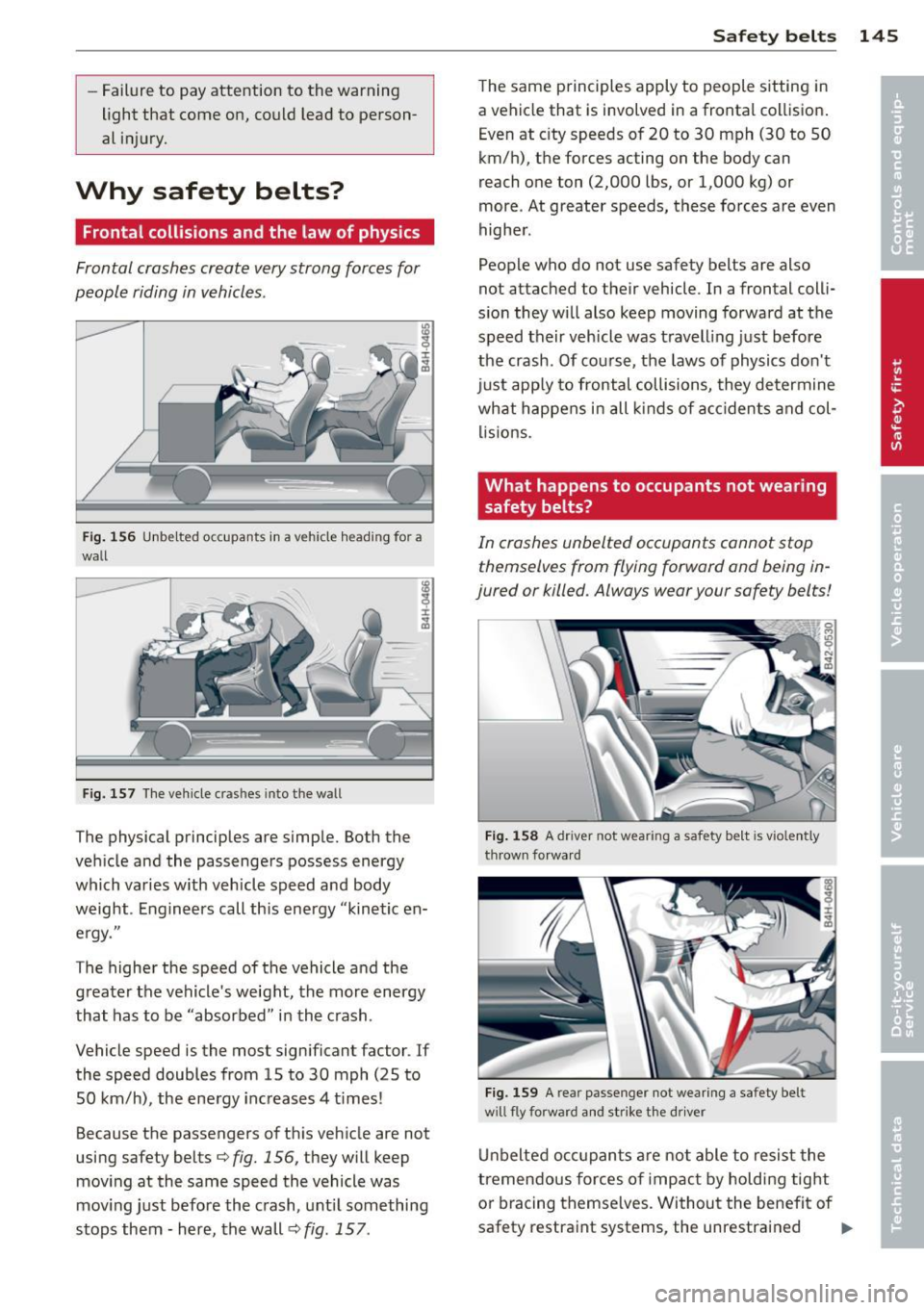
-Failure to pay attention to the warning
light that come on, could lead to personĀ
al injury.
Why safety belts?
Frontal collisions and the law of physics
Frontal crashes create very strong forces for
people riding in vehicles .
Fig. 156 Unbelted occupants in a ve hicle heading for a
wall
Fig. 157 The vehicle cras hes into the wall
The physical principles are simple. Both the
veh icle and the passengers possess energy
which varies w ith veh icle speed and body
weight . Engineers call this energy "kinetic enĀ
e rgy."
The higher the speed of the vehicle and the
greater the vehicle's weight, the more energy
that has to be "absorbed" in the crash.
Vehicle speed is the most significant factor . If
the speed doubles from 15 to 30 mph (25 to
50 km/h), the ene rgy increases 4 t imes!
Because the passengers of th is vehicle are not
using safety beltsĀ¢
fig. 156, they will keep
mov ing at the same speed the vehicle was
mov ing just before the crash, unt il something
stops them - here, the wall Ā¢
fig. 157.
Safety belts 145
The same principles apply to people s itting in
a vehicle that is involved in a frontal collision.
Even at c ity speeds of 20 to 30 mph (30 to 50
km/h), the forces acting on the body can
reach one ton (2,000 lbs, or 1,000 kg) or
more . At greater speeds, these fo rces are even
higher.
Peop le who do not use safety belts are also
not attached to their vehicle . In a frontal colliĀ
s ion they will also keep moving forward at the
speed their vehicle was travelling just before
the crash . Of co urse, the laws of physics don't
just app ly to frontal collisions, they determine
what happens in all kinds of accidents and colĀ
li s ions.
What happens to occupants not wearing
safety belts?
In crashes unbelted occupants cannot stop
themselves from flying forward and being inĀ
jured or killed. Always wear your safety belts!
F ig . 158 A driver not wea ring a safety be lt is vio lently
th rown forwa rd
Fig. 159 A rear passenger not wearing a safety belt
w ill fly forward a nd strike the driver
Unbelted occupants are not able to resist the
tremendous forces of impact by holding tight
or bracing themselves. Without the benefit of
safety restraint systems, the unrestra ined .,..
Page 148 of 318
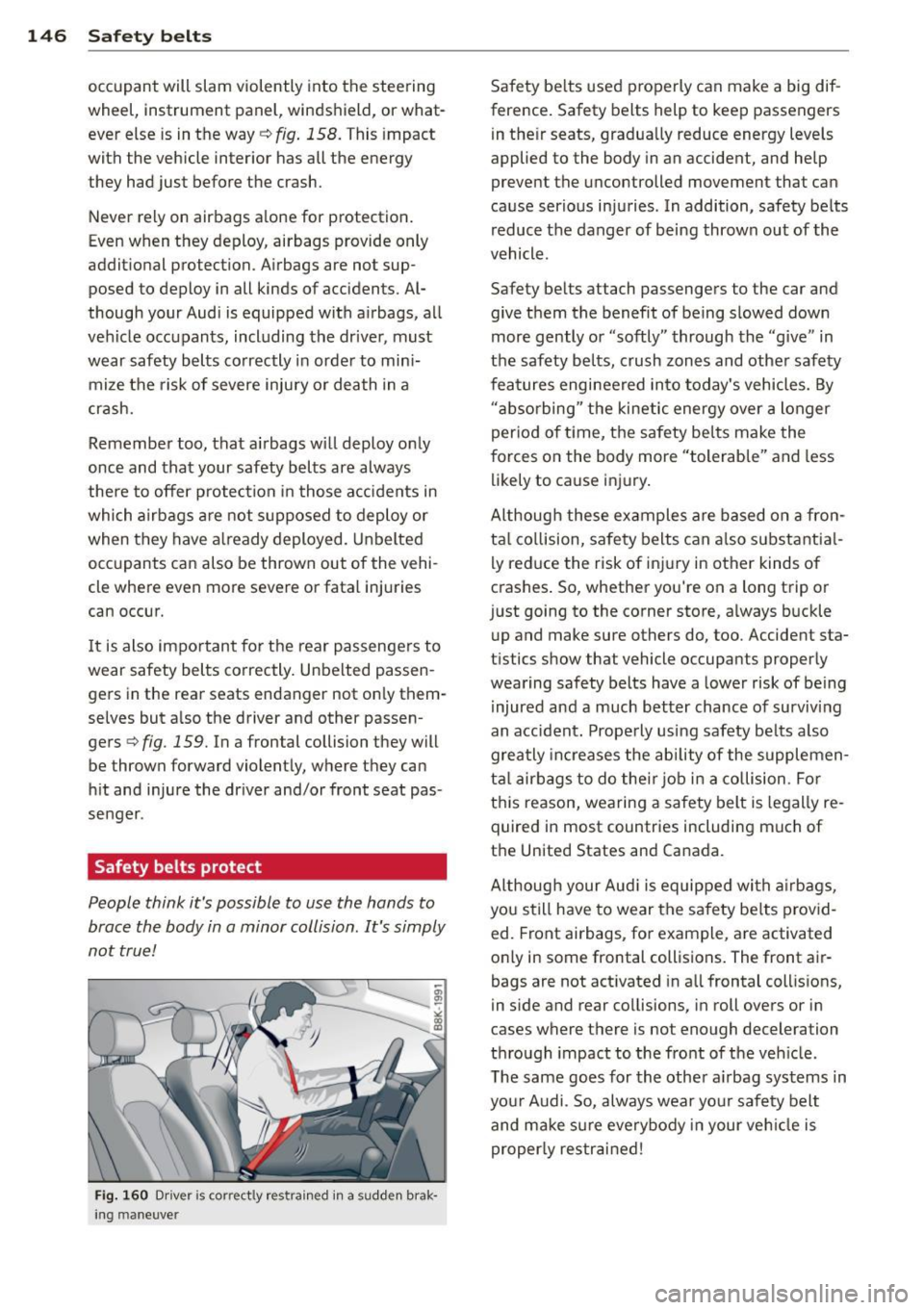
146 Safety belts
occupant will slam violently into the steering
wheel, instrument panel, windshield, or whatĀ
ever else is in the way
c::> fig. 158. This impact
with the vehicle interior has all the energy
t hey had just before the crash.
Never rely on a irbags alone for protection.
Even when they deploy, airbags provide only
additional protection. Airbags are not supĀ
posed to deploy in all kinds of accidents. AlĀ
though your Audi is equipped with airbags, all
vehicle occupants, including the driver , must
wear safety belts correctly in order to miniĀ
mize the risk of severe injury or death in a
crash.
Remember too, that airbags will deploy only
once and that your safety belts are always
there to offer protection in those accidents in
which airbags are not supposed to deploy or
when they have already deployed . Unbelted
occupants can also be thrown out of the vehiĀ
cle where even more severe or fatal injuries
can occur.
It is also important for the rear passengers to
wear safety belts correctly. Unbelted passenĀ
gers in the rear seats endanger not only themĀ
selves but also the driver and othe r passenĀ
gers
~ fig. 159. In a frontal collision they will
be thrown forward violently, where they can
hit and injure the driver and/or front seat pasĀ
senger .
Safety belts protect
People think it's possible to use the hands to
brace the body in a minor collision . It's simply
not true !
Fig. 160 Driver is co rr ect ly re strain ed in a sudd en brakĀ
ing maneuve r
Safety belts used properly can make a big difĀ
ference. Safety belts help to keep passengers
in their seats, gradually reduce energy levels
applied to the body in an accident, and help
prevent the uncontrolled movement tha t can
cause serious injuries . In addition, safety belts
reduce the danger of being thrown out of the
vehicle .
Safety belts attach passengers to the car and
give them the benefit of being slowed down
more gently or "softly" through the "give" in
the safety belts, crush zones and other safety
features engineered into today's vehicles. By
"absorbing " the kinetic energy over a longer
period of ti me, the safety belts make the
forces on the body more "tolerable" and less
likely to cause injury.
Although these examples are based on a fronĀ
tal collision, safety belts can also substantialĀ
ly reduce the r isk of injury in other kinds of
crashes. So, whether you're on a long trip or
just going to the corner store, always buckle up and make sure others do, too. Accident staĀ
tistics show that vehicle occupants properly
wearing safety belts have a lower risk of being
injured and a much better chance of surviving
an accident. Properly using safety belts also
greatly increases the ability of the supplemenĀ
tal airbags to do their job in a collision . For
this reason, wearing a safety belt is legally reĀ
quired in most countries including much of
the United States and Canada.
Although your Audi is equipped with airbags,
you still have to wear the safety belts providĀ
ed. Front airbags , for example, are activated
only in some frontal collisions. The front airĀ
bags are not activated in all frontal collisions,
in side and rear collisions, in roll overs or in
cases where there is no t enough decelera tion
through impact to the front of the vehicle .
The same goes for the other airbag systems in
your Audi . So, always wear your safety belt
and make sure everybody in your vehicle is
properly restrained!
Page 158 of 318
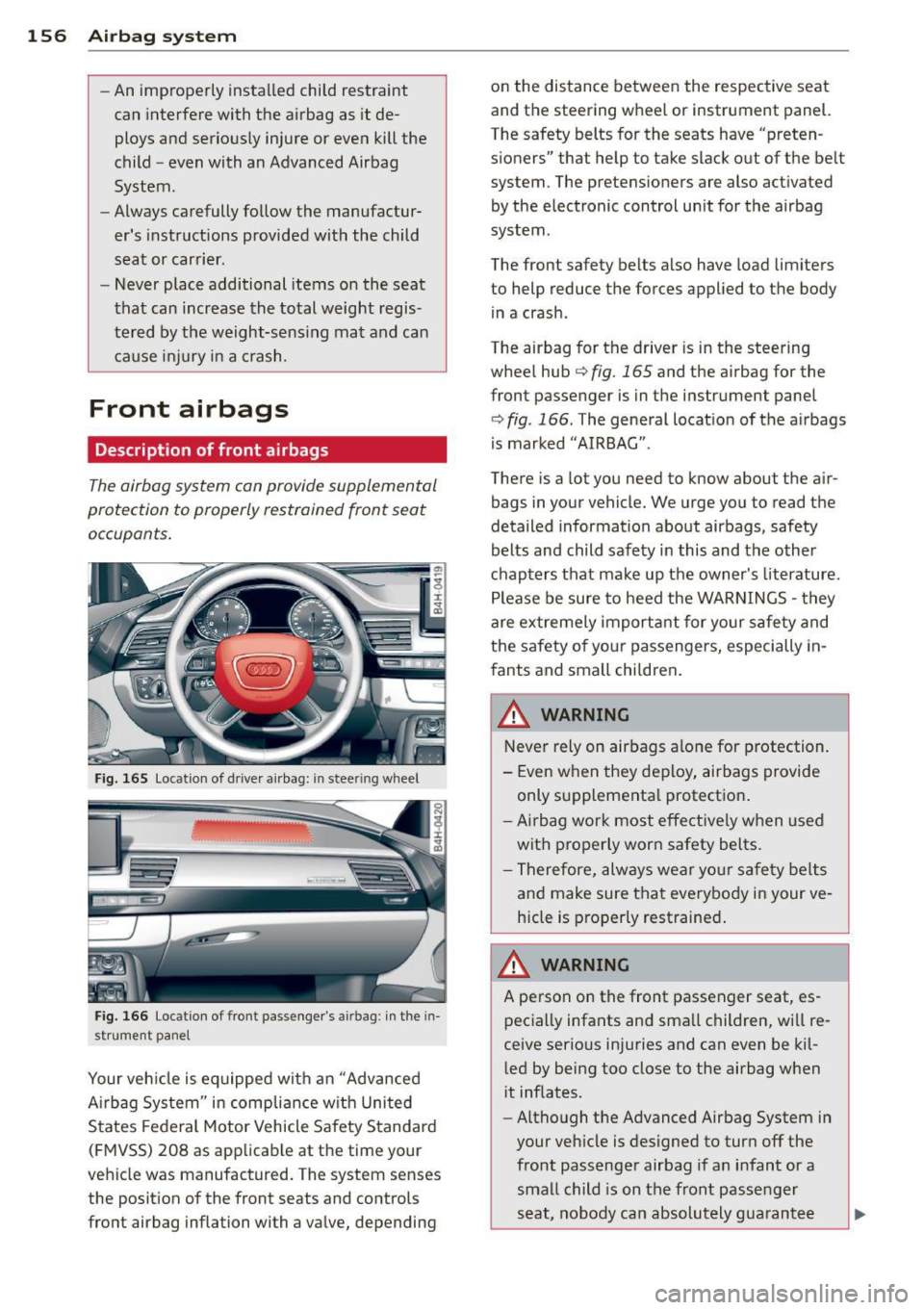
156 Airbag system
-An improperly installed child restraint
can interfere with the airbag as it de Ā
ploys and seriously injure or even kill the
child -even with an Advanced Airbag
System .
- Always carefully follow the manufacturĀ
er's instructions provided with the child
seat or carrier .
- Never place additional items on the seat
that can increase the total weight regisĀ tered by the weight-sensing mat and can
cause injury in a crash .
Front airbags
Description of front airbags
The airbag system con provide supplemental
protect ion to properly restrained front seat
occupants.
Fig. 165 Location of dr iver airbag: in stee ring wheel
Fig. 166 Locat ion of front passenger's airb ag: in the inĀ
s trument panel
Your vehicle is equipped with an "Advanced
A irbag System" in compliance w ith United
States Federal Motor Vehicle Safety Standard
(FMVSS) 208 as applicable at the time you r
vehicle was manufactured. The system senses
the position of the front seats and controls
front airbag inflation with a valve, depending on
the distance between the respective seat
and the steering wheel or instrument panel.
The safety belts for the seats have "pretenĀ sioners" that help to take slack out of the belt
system. The pretensioners are also activated by the electronic control unit for the airbag
system.
The front safety belts also have load limiters
to help reduce the forces applied to the body in a crash .
The airbag for the driver is in the steering
wheel hub
Ā¢fig. 165 and the airbag for the
front passenge r is in the instrument panel
Ā¢ fig . 166 . The general location of the airbags
is marked "AIRBAG".
There is a lot you need to know about the airĀ
bags in your vehicle. We urge you to read the
detailed information about airbags, safety
belts and child safety in this and the other
chapters that make up the owner's literature .
Please be sure to heed the WARNINGS -they
are extremely important for your safety and
the safety of you r passengers, especially inĀ
fants and small children.
A WARNING
Never rely on airbags alone for protection.
- Even when they deploy, airbags provide
only supplementa l protection .
-Airbag work most effective ly when used
with properly worn safety belts.
- Therefore, always wear your safety belts
and make sure that everybody in your ve Ā
hicle is properly restrained .
A WARNING
A person on the front passenger seat , esĀ
pecially infants and sma ll children, will reĀ
ceive serious injuries and can even be kilĀ
led by being too close to the airbag when
it inflates .
- Although the Advanced Airbag System in
your vehicle is designed to turn off the
front passenger airbag if an infant or a
small child is on the front passenger
seat, nobody can absolutely guarantee ..,.
Page 160 of 318
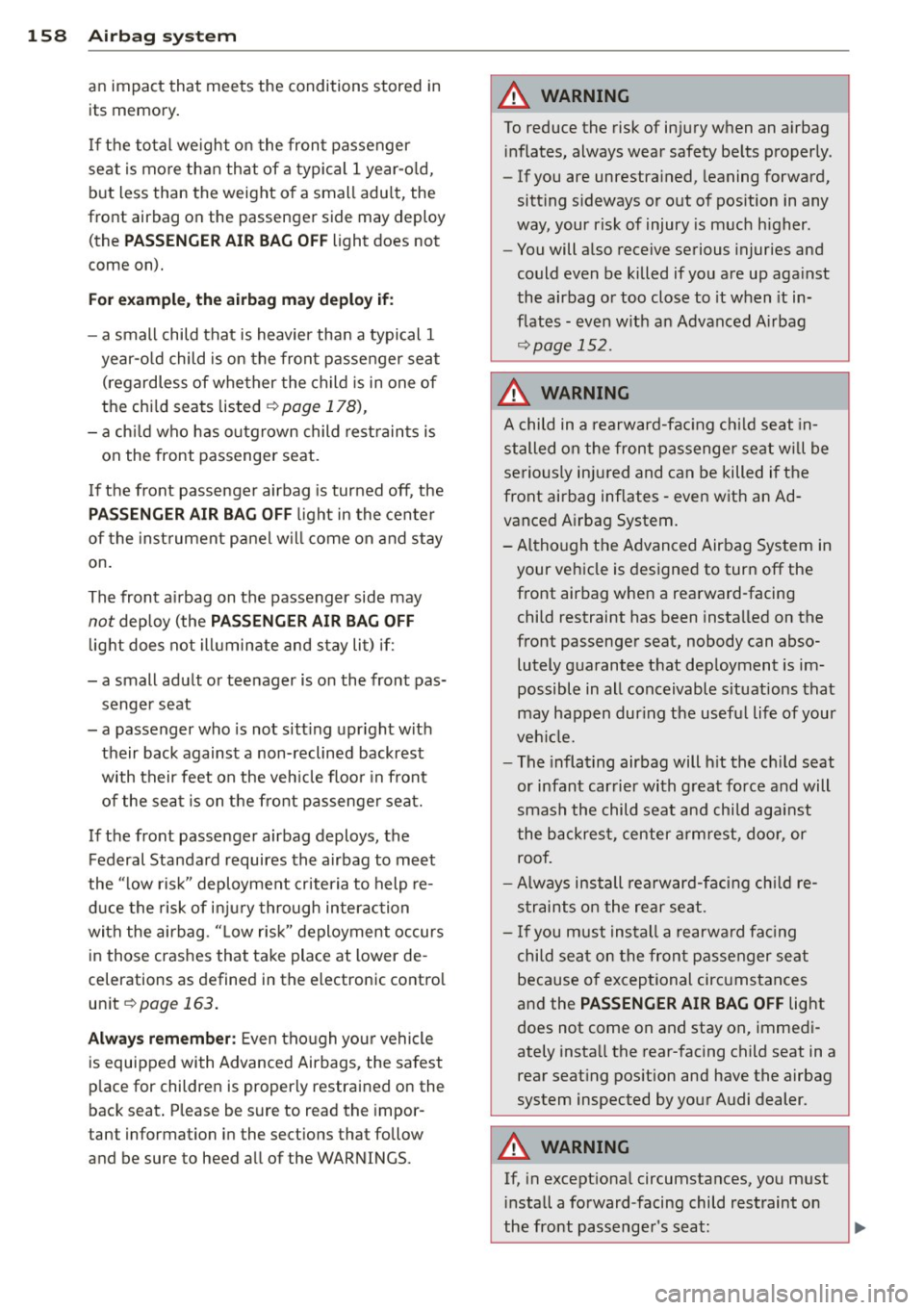
158 Airb ag sys te m
an impact that meets the conditions stored in
its memory .
I f the total weight on the front passenger
seat is more than that of a typical 1 year-o ld,
but less than the weight of a small adu lt, the
front airbag on the passenger side may deploy (the
PASSENGER AIR B AG OFF light does not
come on).
For exa mple , the airbag ma y depl oy if :
- a small child that is heavier than a typical 1
year-o ld child is on the front passenger seat
(regardless of whe ther the child is in one of
the chi ld seats listed
Ā¢ page 178),
- a ch ild who has outgrown child rest raints is
on the front passenger seat.
If the front passenger airbag is turned off, the
PA SSENGER AIR BAG OFF light in the cente r
of the instrument panel w ill come on and stay
on.
The front a irbag on the passenger side may
not deploy (the PAS SENGER AIR BAG OFF
light does not illuminate and stay lit) if:
- a small adult or teenager is on the front pasĀ
senger seat
- a passenger who is not sitt ing upright wit h
their back against a non-reclined backrest
with their feet on the veh icle floo r in front
of the seat is on the front passenger seat.
If the front passenger airbag deploys, the Federal Standard requires the a irbag to meet
the "low risk" deployment criteria to help reĀ
d uce the risk of inju ry through interaction
with the airbag. " Low risk" deployment occurs
in those crashes that take place at lower deĀ
celerations as defined in the electronic control un it
Ā¢ page 163.
Alw ays re memb er: Even tho ugh you r vehicle
is equipped with Advanced Airbags, the safest
p lace for children is properly restrained on the
back seat . Please be sure to read the imporĀ
tant information in the sect ions that follow
and be sure to heed all of the WARNINGS.
A WARNING
To reduce the risk of injury when an a irbag
i nflates, always wear safety be lts properly.
- If you are unrestra ined, leaning forward,
sitt ing s ideways or out of pos ition in any
way, your risk of injury is much h igher.
- You will a lso receive serious injuries and
could even be killed if you are up aga inst
the airbag or too close to it when it inĀ
flates -even w ith an Advanced A irbag
Ā¢ page 152.
A WARNING
A child in a rearward-fac ing ch ild seat inĀ
stalled on the front passenger se at will be
se riously injured and can be killed if the
front airbag inflates -even with an AdĀ
vanced Airbag System.
- Altho ugh the Advanced Airbag System in
your vehicle is designed to turn off the
front airbag when a rearward-facing
child restraint has been installed on the
front passenger seat, nobody can absoĀ
lutely guarantee that dep loyment is imĀ
possible in all conceivable situations that
may happen dur ing the usefu l life of your
veh icle.
- The inflating airbag will h it the ch ild seat
or infant car rier with g reat force and will
smash the child seat and child against
the backrest, center armrest, door, or
roof.
- Always install rearward-facing ch ild reĀ
s traints on the rear seat.
- I f you must ins tall a rearward fac ing
child seat on the fron t passenger seat
because of exceptional circumstances
and the
PASSENGER AIR BAG OFF light
does not come on and stay on, immediĀ
ately insta ll the rear-facing child seat in a
rear seat ing pos ition and have the airbag
system inspected by your Audi dealer.
A WARNING
If, in exceptional circumstances, you must
i nstall a forward-facing child restraint on
the front passenger's seat:
-
Page 169 of 318
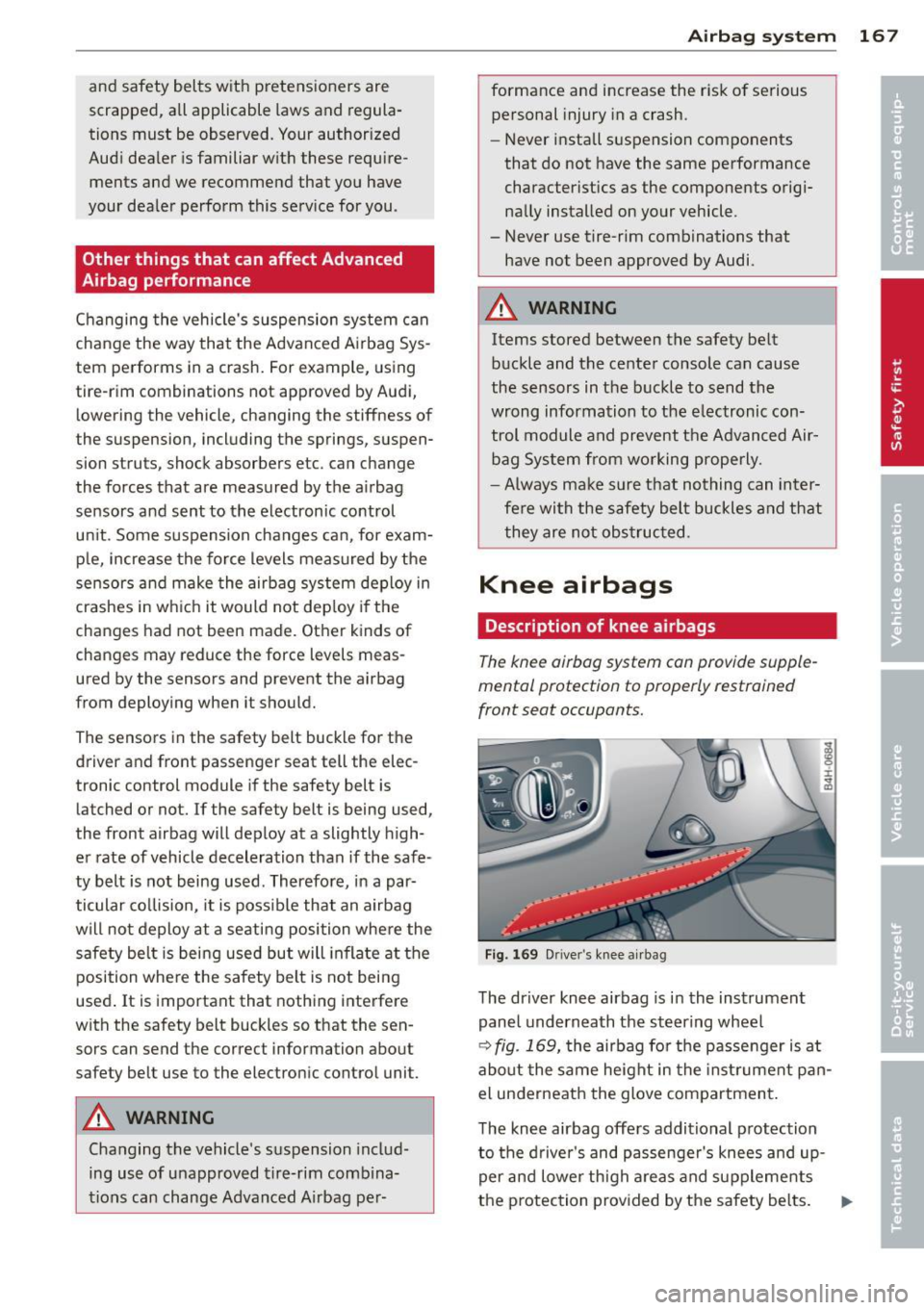
and safety belts with pretensioners are
scrapped, all applicable laws and regulaĀ
tions must be observed. Your authorized
Audi dealer is familiar with these requireĀ
ments and we recommend that you have
your dealer perform this service for you .
Other things that can affect Advanced
Airbag performance
Changing the vehicle's suspension system can
change the way that the Advanced Airbag SysĀ
tem performs in a crash. For example, using
tire-rim combinations not approved by Audi,
lowering the vehicle, changing the stiffness of
the suspension, including the springs, suspenĀ
sion struts, shock absorbers etc. can change
the forces that are measured by the airbag
sensors and sent to the electronic control
unit. Some suspension changes can, for examĀ ple, increase the force levels measured by the
sensors and make the airbag system deploy in
crashes in which it would not deploy if the
changes had not been made. Other kinds of
changes may reduce the force levels measĀ
ured by the sensors and prevent the airbag
from deploying when it should.
The sensors in the safety belt buckle for the
driver and front passenger seat tell the elecĀ
tronic control module if the safety belt is
latched or not. If the safety belt is being used,
the front airbag will deploy at a slightly highĀ
er rate of vehicle deceleration than if the safeĀ
ty belt is not being used. Therefore, in a parĀ
ticular collision, it is possible that an airbag
will not deploy at a seating position where the safety belt is being used but will inflate at the
position where the safety belt is not being
used . It is important that nothing interfere
with the safety belt buckles so that the senĀ
sors can send the correct information about
safety belt use to the electronic control unit.
A WARNING
Changing the vehicle's suspension includĀ
ing use of unapproved tire-rim combinaĀ
tions can change Advanced Airbag per-
Airbag system 167
formance and increase the risk of serious
personal injury in a crash.
- Never install suspension components
that do not have the same performance characteristics as the components origiĀnally installed on your vehicle.
- Never use tire-rim combinations that have not been approved by Audi.
A WARNING
Items stored between the safety belt buckle and the center console can cause
the sensors in the buckle to send the
wrong information to the e lectronic conĀ
trol module and prevent the Advanced AirĀ
bag System from working properly.
- Always make sure that nothing can interĀ
fere with the safety belt buckles and that
they are not obstructed.
Knee airbags
Description of knee airbags
The knee airbag system can provide suppleĀ
mental protection to properly restrained
front seat occupants.
Fig . 169 Driver 's knee airbag
The driver knee airbag is in the instrument
panel underneath the steering wheel
Ā¢ fig . 169, the airbag for the passenger is at
about the same height in the instrument panĀ
el underneath the glove compartment.
The knee airbag offers additional protection
to the driver 's and passenger's knees and upĀ
per and lower thigh areas and supplements
the protection provided by the safety belts.
Ill-
Page 201 of 318
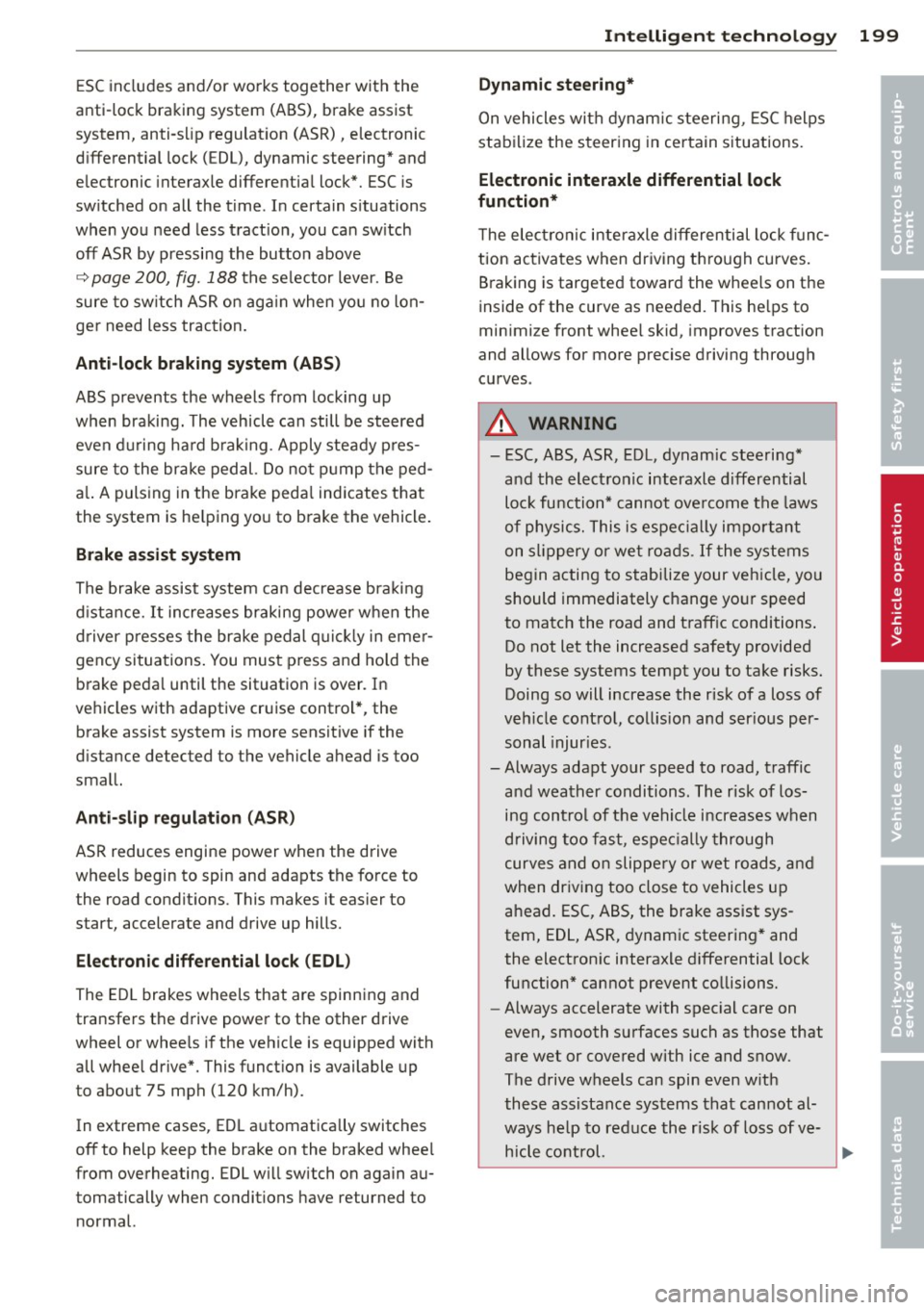
ESC includes and/or works together with the
anti-lock braking system (ABS), brake assist
system, anti-s lip regulat ion (ASR), electronic
d ifferential lock (EDL), dynamic steering* and
electronic interaxle differential lock*. ESC is
sw itched on all the time . In certain s ituations
when you need less tract ion, you can sw itch
off ASR by pressing the button above
~ page 200, fig. 188 the se lector lever. Be
sure to sw itch ASR o n aga in when yo u no lonĀ
ger need less traction.
Anti -lock braking system (ABS)
ABS prevents the wheels from locking up
when braking. The veh icle can still be steered
even du ring ha rd b raking . Apply steady p resĀ
sure to the brake pedal. Do not p ump the pedĀ
a l. A pulsing in the brake peda l indicates that
the system is he lping you to brake the vehicle .
Brake as sist system
The brake assist system can decrease bra king
d istance.
It increases braking power when the
driver presses the brake pedal qu ick ly in eme rĀ
gency situations . You must p ress and ho ld the
brake peda l until the situation is over. In
vehicles with adaptive cruise control*, the
brake assist system is more sensit ive if the
d istance detected to the vehicle ahead is too
small.
Anti- slip regulati on (A SR )
ASR reduces engine power when the drive
wheels begin to spin and adapts the force to the road condit ions. This makes it eas ier to
start, accelerate and drive up hills.
Electronic diff erential lo ck (EDL )
The ED L brakes wheels that are spinning and
transfers the drive power to the other drive
wheel or whee ls if the vehicle is equipped with
all whee l drive*. This funct ion is available up
to about 75 mph (120 km/h).
In extreme cases, EDL automatica lly switches
off to help keep the brake on the braked whee l
from overheating. EDL w ill switch on again auĀ
tomatically when conditions have returned to normal.
Int ellig ent technolog y 199
Dynamic ste ering *
On vehicles with dynam ic steering, ESC helps
stabilize the steering in certain situations.
Electronic intera xle differential l ock
function*
T he electron ic i nteraxle differential lock f unc Ā
tion activa tes when dr iving th ro ugh curves.
Braking is targeted toward the wheels on the
inside of the curve as needed. This he lps to
minimize front whee l skid, improves traction
and allows for more precise driving through curves .
A WARNING
- ESC, ABS, ASR, EDL, dynamic steering*
and the elect ronic interaxle differential
loc k function* cannot ove rcome the laws
of physics. This is espec ially important
on slippery or we t roads.
If the systems
begin acting to stabilize your veh icle, you
should immediately change yo ur speed
to match the road and traffic conditions .
Do not let the increased safety provided
by these systems tempt you to take risks.
Doing so will increase the risk of a loss of
veh icle contro l, collision and ser ious perĀ
sonal injur ies.
- Always adapt your speed to road, traffic and weather conditions. The risk of losĀing con trol of the vehicle increases when
driving too fast, espe cially through
curves a nd on slippe ry or wet roads, and
when dr iving too close to vehicles up
ahead. ESC, ABS, the brake assist sysĀ
tem, EDL, ASR, dynam ic steering* and
the electron ic interaxle d ifferential lock
function" cannot prevent co llisions.
- Always accelerate with spec ial care on
even, smooth surfaces such as those that
are wet or covered with ice and snow.
The drive wheels can spin even w ith
these assistance systems that cannot alĀ
ways he lp to red uce the risk of loss of veĀ
hicle control.
-
ā¢
ā¢
Page 202 of 318

200 Intelligent technology
-ABS and ASR on ly work correctly when
all four wheels are equipped w ith ident iĀ
ca l tires. Different tire s izes can lead to a
reduction in engine power.
- You may hear noises when the systems described are working.
- If the indicator light
DJ or m:11 (USA
models) ;tiJ (Canada models) appears,
there may be a malfunct ion
c::;, page 19,
c::;, page 18 .
Switching on and off
ESC turns on automatically when you start
the engine.
Fig. 188 Center console w ith ESC OFF button
Switching ASR off (sport mode)
In certain situat io ns, you can switch ASR and
ESC into sport mode by pressing the button
l!l
c::;, fig. 188. The indicator light II comes on
and the mess age Stabilization control (ESC ):
Off warning! Reduced stability appears. ASR
deactivates completely and the assistance provided by the ESC system is limited. Switch
to sport mode on ly when your driving skills,
traffic and weather cond itions permit .
I n some situations, it may be useful to switc h
ASR off to let the wheels slip. Example:
- Rocking the vehicle back and forth when it is
stuck
- Driving in deep snow or on loose ground
- Driving with snow cha ins
Switching ASR on Press the button[!] aga in. The message StabiĀ
lization control (ESC): On appears.
A WARNING
- Drive whee ls can sp in and you can lose
control of the vehicle more eas ily when
ASR and ESC are in sport mode, especialĀ
ly when the road is slippery.
- Sw itch to sport mode only when your
driving skills, traff ic and weather condiĀ
tions permit.
@ Tips
You cannot sw itch sport mode on when
adaptive c ruise control* is working.
Braking
General information
What affects braking efficiency?
-
Operating conditions and driving habits
The brakes on today's automobiles are still
subject to wear, depending largely on operatĀ
ing condit ions and driving habits
c::;, &. . On
vehicles that are either dr iven mostly in stopĀ
and-go city traffic or are driven hard, the
brake pads should be checked by your authorĀ
ized Audi dea ler more often than specified in
the Warranty
& Maintenance booklet. Failure
to have your brake pads inspected can result
in reduced brake performance.
On steep slopes, you should use the braking
effect of the engine. This way, you prevent unĀ
necessary wear on the brake system. If you
must use your brakes, do not hold the brakes
down continuously. Pump the brakes at interĀ
vals .
Operating noise
Noises may occur when braking depending on
the speed, braking force and outside condiĀ
tions such as temperature and humidity.
Due to the nature of the materia ls used in ceĀ
ramic brake rotors*, noises may become more
apparent at low speeds. .,..
Page 203 of 318
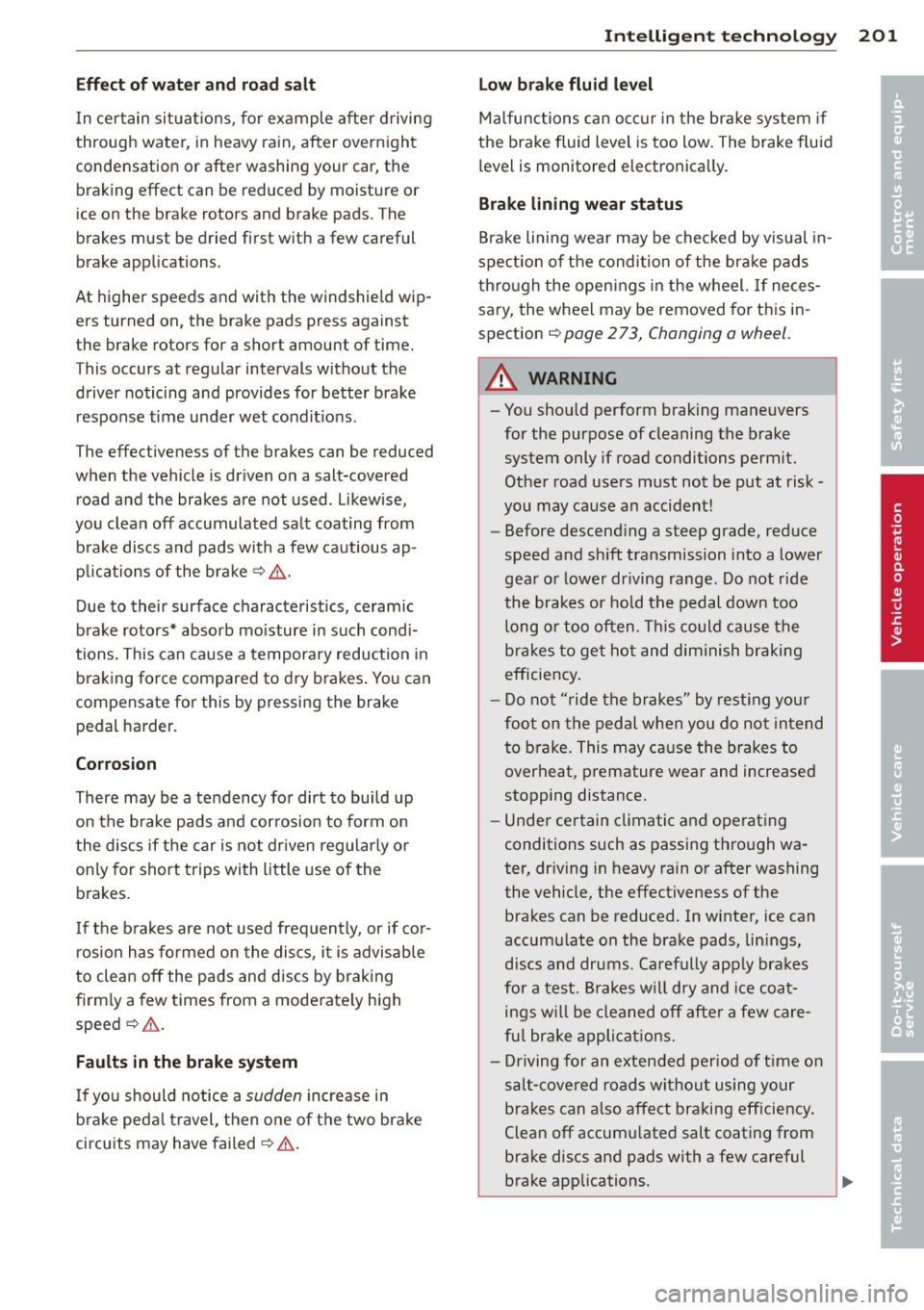
Effect of w ate r and ro ad sa lt
In certain situa tions, for example after driving
through water, in heavy rain, after overnight
condensation or after washing your car, the
braking effect can be reduced by moisture or
ice on the brake rotors and brake pads. The
brakes must be dried first wit h a few careful
brake applications.
At higher speeds and with the windshield wip Ā
ers turned on, the brake pads press against
the brake rotors for a short amount of time.
This occurs at regular intervals w ithout the
driver noticing and provides for better brake response time under wet condit ions.
The effectiveness of the brakes can be reduced
when the vehicle is dr iven o n a salt-covered
road and the brakes are not used . Likewise,
you clean
off accumulated sa lt coating from
brake discs and pads with a few caut ious apĀ
p lications of the brakeĀ¢&. -
Due to their surface characteristics, ceram ic
brake roto rs* absorb mo isture in such condiĀ
tions. This can cause a temporary reduction in
b rak ing fo rce compared to d ry brakes. You can
compensate for this by pressing the brake pedal harder .
Corrosion
There may be a tendency for dirt to build up
on the brake pads and corrosion to form on
the discs if the car is not dr iven regularly or
on ly for short t rips with little use of the
brakes.
I f t he b rakes are not used frequently, or if co rĀ
rosion has formed on the dis cs, it is advisable
to clean
off the pads and discs by brak ing
firm ly a few times from a moderately high
speed Ā¢.&. .
Faults in the brake system
If you should notice a sudden increase in
b rake peda l travel, then o ne of the two bra ke
circuits may have failed~ .&..
Int ellig ent technolog y 201
Low br ake fluid level
Malfunctions can occu r in the bra ke system if
the b rake fluid level is too low. The brake fluid
level is monitored electronica lly.
Brake lining wear status
B rake lining wear may be checked by visual inĀ
spe ct ion of the condition of the brake pads
through the open ings in the wheel. If necesĀ
sary, the whee l may be removed for this inĀ
spection
r=;, page 2 7 3, Changing a wheel.
_& WARNING
-You should perform braking maneuvers
for the purpose of cleaning the brake
system only if road conditions permit.
Other road users must not be put at risk -
you may cause an accident!
- Before descend ing a steep grade, reduce
speed and sh ift transmission into a lower
gear or lower dr iving range . Do not ride
the brakes or hold t he pedal down too
long o r too often. Th is could cause the
brakes to get hot and diminish braking
efficiency .
- Do not "ride the brakes" by rest ing you r
foo t on the pedal when you do not intend
to b rake . This may cause the brakes to
overheat, premature wear and increased
stopping distance.
- Under certain climatic and operating
conditions such as passing thro ugh waĀ
ter, dr iv ing in heavy rain or after washing
the vehicle, the effectiveness of the brakes can be reduced. In winter, ice can
accumu late on the brake pads, lin ings,
discs and drums . Carefully app ly brakes
for a test. Brakes w ill dry and ice coatĀ
ings w ill be cleaned
off after a few careĀ
fu l brake applicat ions.
- Driving for an extended period of time on
salt- cove red roads without using your
brakes can a lso affect braking efficiency .
Clean
off accum ulated salt coating from
brake discs and pads with a few careful
brake applications.
ā¢
ā¢
Page 213 of 318
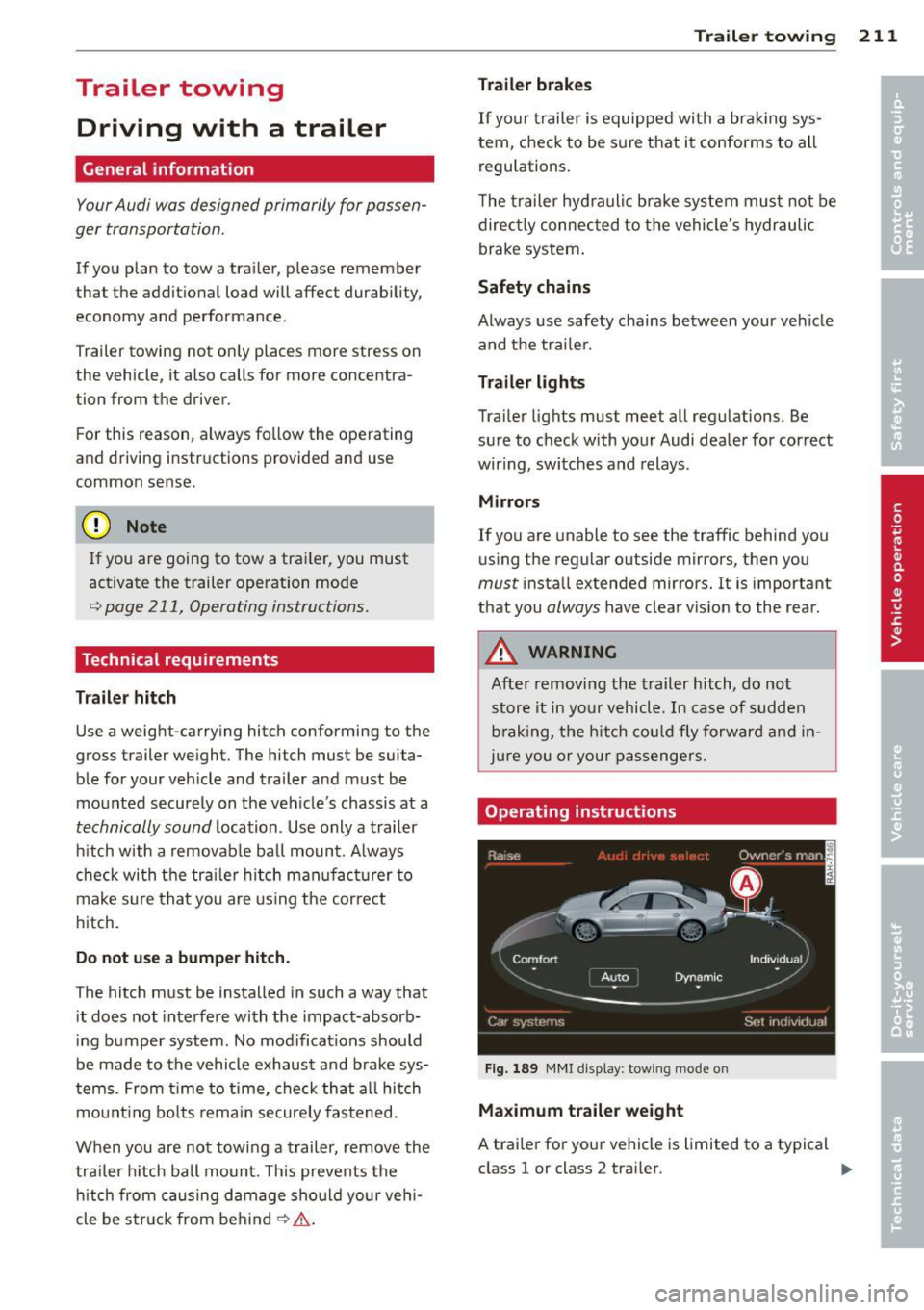
Trailer towing Driving with a trailer
General information
Your Audi was designed primarily for passenĀ
ger transportation .
If you plan to tow a trai ler, p lease remember
that the addit ional load will affect durab ility,
economy and performance .
Trailer towing not on ly places more stress on
the vehicle, it also calls for more concentraĀ
tion from the driver.
F or this reason, a lways fo llow the operating
and d riving instr uctions provided and use
common sense.
(D Note
If you are going to tow a trai ler, you must
activate the trailer operat ion mode
~ page 211, Operating instructions.
Technical requirements
Trailer hitch
Use a weight-carrying hitc h co nforming to the
gross trailer we ight. The hitch must be suitaĀ
b le for your veh icle and trailer and must be
mounted secure ly on the veh icle's chassis at a
technically sound location . Use only a trailer
hi tch wit h a removab le ball moun t. A lways
check with t he trail er hitch ma nufactur er to
make sure tha t you are using the corre ct
hi tch.
Do not use a bumper hitch.
The hitc h must be installed in such a way that
i t does not interfere with the impac t-absorbĀ
i ng bumpe r sys tem. No mod ifica tio ns should
be made to the vehicle exh aust a nd brake sysĀ
tems . From time to time, check that a ll hitch
mo unt ing bolts remain securely fastened.
W hen you are not towing a trail er, remove the
traile r hitch ball mount. Th is prevents the
hi tch from causing damage sho uld your ve hiĀ
cle be str uck from behind Ā¢& .
Trailer towin g 211
Trailer brakes
If your trailer is equippe d wi th a br akin g sys Ā
tem, check to be s ure that i t conforms to all
r egulations .
T he trailer hy draul ic brak e sys tem mus t not be
direc tly connec ted to the vehi cle' s h ydraulic
brake system .
Safety chains
Always use safety chains between your veh icle
and the tra ile r.
Trailer lights
Trai ler lights must meet all regu lations. Be
su re to check with your Audi dealer for cor rect
wir ing, swi tches and relays .
Mirrors
If you are unable to see the traffic behind you
us ing the reg ular o utside mirrors, then you
must insta ll extended mirrors. It is imp ortant
that you
always have clea r v is ion to the rear.
A WARNING ...__ -
Afte r removing the trailer hitch, do not
stor e it i n yo ur v ehicl e. In cas e o f sudden
b ra king, the hitch co uld fly forwar d and inĀ
ju re you or your p ass en ger s.
Operating instructions
Fi g. 189 MM I dis pl ay: tow ing mode on
Ma ximum trailer weight
A trai ler fo r you r vehicle is limited to a typical
class 1 or class 2 tra iler.
ll>
Page 215 of 318

drive at the maximum permissible speed. ReĀ
duce your speed even more if load, weather or
wind condit ions are unfavorable -part icularly
when going downhill.
Reduce vehicle speed
immediatel y if the trailĀ
er shows the slightest sign of swaying .
Do not
try to stop the swaying by accelerating.
Observe speed limits . In some areas, speeds
for vehicles towing trailers are lower than for
regular vehicles .
A lways app ly brakes early. When driving
downhill, shift into a lower gear to use the enĀ
gine braking effect to slow the vehicle . Use of
the brakes a lone can cause them to overheat
and fail.
Coolant temperature
The coolant temperature gauge c:> page 10
must be observed carefully. The coo lant temĀ
perature can increase if you drive on long in Ā
clines in a low gear at high engine speeds. ReĀ
duce your speed immed iate ly if the L EDs in
the top part of the display turn on.
F or more information about indicator lights,
refer to. ~
page 16.
A WARNING
Anyone not properly restrained in a movĀ
ing vehicle is at a much greater risk in an
accident . Never let anyone r ide in your car
who is not properly wear ing the restra ints
provided by Aud i.
Trailer towing tips
Important to know
Your veh icle hand les different ly when tow ing
-
a trailer because of the addit ional weight and
d ifferent weight distribution . Safety, performĀ
ance and economy will greatly depend on how
carefully you load your trailer and operate
your ng .
Before you actually tow your trailer, practice
turning, stopping and backing up in an area
away from traffic. Keep practicing until you
Trailer towing 213
have become completely familiar with the way
your vehicle-trai ler combination behaves and
responds.
Backing up is difficult and requires practice .
Backing up with a t railer generally requires
steering action opposite to that when backing
up your vehicle without a tra iler.
Maintain a greater distance between your veĀ
hicle and the one in front of you . You wi ll need
more room to stop. To compensate for the
trailer, you w ill need a larger than normal
turning radius.
When passing, remembe r that you cannot acĀ
ce lerate as fast as you norma lly would beĀ
cause of the added load. Make sure you have
enough room to pass. After passing, allow plenty of room for your trailer before changĀ
ing lanes again.
Avoid jerky starts, sharp turns or rapid lane changes.
(D Tips
- Do not tow a trailer during the break-in
period of your vehicle.
- If you tow a trailer, your Audi may re Ā
quire more frequent maintenance due to
the extra load
c:> page 296.
Parking on a slope
Do not park on a slope with a trailer. If it canĀ
not be avoided, do so only a~er doing the folĀ
lowing:
When parking:
.,. App ly the foot brake.
.,. Have someone p lace chocks under both the
vehicle and the trailer wheels .
.,. With chocks in place, slowly release the
brakes until the wheel chocks absorb the
load.
.,. Turn the wheels towards the curb .
.,. Apply the parking brake .
.,. Select the P selector lever posit ion .
When restarting after parking:
.,. Apply the foot brake.
ā¢
ā¢